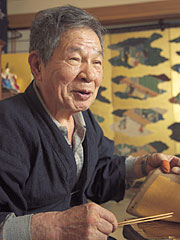Special Feature![]() “Japan, the Land of Gold.” How True Is the Old Legend?
“Japan, the Land of Gold.” How True Is the Old Legend?
Making Gold Glitter
More Beautifully
Gold leaf is made by beating gold until it is unbelievably thin. Sprinkled gold illustrations, or maki-e, are made by sprinkling gold powder on lacquer. These techniques have added glitter and beauty to Buddhist statues and artwork since ancient times. This article introduces two expert gold artisans who work in Ishikawa Prefecture, in the Hokuriku region.
Written by Sanada Kuniko
Photos by Kawada Masahiro
Just one-10,000th of a millimeter “thick,” thanks to a special washi paper
Aoji Rokunosuke, gold leaf artisan
The walls of the Golden Pavilion in Kyoto, the shining surfaces of an austere Buddhist statue, an ornate picture on a partition or folding screen, threads in a sparkling kimono design—they all have one thing in common: gold leaf, shining bright and pure.
“Hey, look—you can almost see right through it!” Aoji Rokunosuke stops working for a moment and holds up a piece of super-thin gold leaf. He works at Sakuda, a company that makes and sells gold leaf in Kanazawa, Ishikawa Prefecture. More than 99% of all the gold leaf produced in Japan comes from the city of Kanazawa.
Gold leaf is made from gold that has tiny amounts of silver and copper added to it. It becomes thinner and thinner under a repetitive process. When the leaves are about one-1,000th of a millimeter in thickness, they are layered individually between sheets of a special Japanese paper called hakuda-shi. Then they are beaten thinner and thinner yet. At Sakuda, Aoji is in charge of this process. In the old days it was done by hand, but today they use a hakuda-ki machine.
The machine makes quite a racket, repeating its up-down motion 700 times a minute. The leaf is thinned and pushed out uniformly, slowly and surely, as Aoji moves the bundle of paper and gold under the hammering device. It is a little scary watching—it looks like the machine could clip his fingers at any moment. The gold leaf ends up just one- or two-10,000ths of a millimeter thin.
“Japan is the only country in the world where gold leaf is made as thin as this.” Aoji is obviously proud of his work. “The key is in the preparation of the hakuda-shi paper.”
A traditional washi paper called ganpi-shi is soaked in a liquid mixture of straw ash lye, persimmon juice and chicken eggs. Then Aoji taps it with the hakuda-ki machine, gently, time after time. The paper becomes shiny and wafer-thin, taking on the appearance of waxed paper. Under the tap-tapping of the hammer, and sandwiched between sheets of this satiny, perfectly smooth paper, the gold leaf spreads out without any micro lumps or valleys.
And so, the secret behind the superlative quality of Kanazawa gold leaf is in those finely made sheets of paper.


